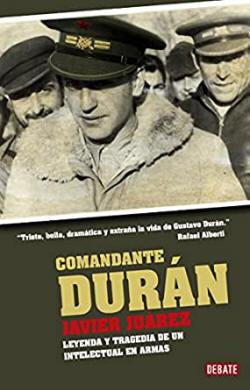

Queer Places:
Saint Onoufrios Church, Alones 740 58, Greece
 Gustavo Durán Martínez (1906–1969) was a Spanish composer,[1] Lieutenant Colonel in the Spanish military, diplomat and United Nations official.[2]
His figure inspired Ernest
Hemingway's For Whom the Bell Tolls, Andre Malraux's L'Espoir.[18] and Max Aub's Campo de Sangre. Horacio Vázquez-Rial wrote El soldado de porcelana about him.
Román Gubern writes about the gay group which surrounded Salvador Dalí and
Federico García
Lorca (among them,
Luis Cernuda, Benjamín Palencia,
Juan Gil-Albert,
Vicente
Aleixandre, Gustavo Durán and
Eduardo Blanco Amor) men who were “compañeros
de [la] constelación cultural de García Lorca”.
Gustavo Durán Martínez (1906–1969) was a Spanish composer,[1] Lieutenant Colonel in the Spanish military, diplomat and United Nations official.[2]
His figure inspired Ernest
Hemingway's For Whom the Bell Tolls, Andre Malraux's L'Espoir.[18] and Max Aub's Campo de Sangre. Horacio Vázquez-Rial wrote El soldado de porcelana about him.
Román Gubern writes about the gay group which surrounded Salvador Dalí and
Federico García
Lorca (among them,
Luis Cernuda, Benjamín Palencia,
Juan Gil-Albert,
Vicente
Aleixandre, Gustavo Durán and
Eduardo Blanco Amor) men who were “compañeros
de [la] constelación cultural de García Lorca”.
Born in Barcelona, Spain in 1906, he moved with his family to Madrid at the age of four, and studied music. During his piano studies he befriended Federico García Lorca,[1] Salvador Dalí, Buñuel, Rafael Alberti (some of whose poems he set to music) and other Residencia de Estudiantes guests.[3] In 1927 he composed a ballet, Fandango del Candil, for Spanish dancer Antonia Mercé, La Argentina, and accompanied her on a European tour. In 1929 he moved to Paris where he studied under Paul Le Flem of the Schola Cantorum and served, until 1934, as manager and secretary to the Spanish painter Néstor. In 1933 he became an employee of the Spanish section of Paramount Pictures, and continued in that role, after returning to Madrid, at Fono-Espana, Inc., where he dubbed and scored films[4] for the Latin American market. Before the war, he was a leading figure in the Motorizada, the motorized section of the socialist youth movement associated with Prieto.[5]
He served in the Army of the Spanish Republic from July 18, 1936 until the end of war. In 1936 he was the chief of staff of Kleber.[6] Later, he joined the PCE. After that, he was the republican commander of one Mixed Brigade in the Second Battle of the Corunna Road in November 1936[5] and in the Segovia Offensive[7] and the Battle of Brunete he led the 69th division.[8] He covered the retreat of the republican forces in the Maestrazgo during the Aragon Offensive[9] and was one of the Republican commanders in the defense of the XYZ Line in 1938.[10][11] He also served briefly in SIM, the (Servicio de Investigación Militar), as chief of the department for the Army of the Centre.[12] In March 1939, when Franco's troops had reached Valencia, Durán escaped from Gandia, Spain, aboard a British destroyer, landing at Marseille and, eventually, London.
Durán married Bontë Romilly Crompton, in Totnes, Devon on 4 Dec 1939.[16] Bontë (15 May 1914 - 6 January 2002) was the eldest daughter of David Henry Crompton and Lillian MacDonald Sheridan; she was a great-granddaughter of John Romilly, 1st Baron Romilly, her sister Catherine married Baron Henry Walston. Durán and Bontë were the parents of Cheli Durán Ryan, an author of children's books; Lucy Durán, ethnomusicologist; and Jane Duran, poet.[17]
In May 1940, Durán emigrated to New York City, where he was employed by the Office of the Coordinator of Inter-American Affairs to work at the Museum of Modern Art. From there he moved to the Music Division of the Pan American Union, Washington. In 1942, he was granted US citizenship and was transferred to the Havana embassy[13] on the recommendation of his old friend Ernest Hemingway, who had made him a character in his novel For Whom The Bell Tolls. In May 1945, he went to Buenos Aires, where he served as assistant to the Ambassador, Spruille Braden.
In October, 1946, after rising to the position of special assistant to the Assistant Secretary of State, he resigned from the State Department and entered the United Nations,[13] where he served as an officer in the Social Department of the Refugee Division. He was accused that year by a U.S. Representative, J. Parnell Thomas, of being an agent of the Russian police and a member of the Comintern. In 1951, Senator Joseph McCarthy, drawing on a report written for the Spanish Falangist journal Arriba (Madrid), denounced him as a communist and member of the Communist-dominated military intelligence, SIM.[13][14] As a UN officer, he helped start Unesco, CEPAL and was sent to Congo in 1960.
He died in Athens in 1969 and he was buried in Alones of Rethymno in Crete.[15] When he was alive he visitied Alones and was so impressed with the village life and the hospitality offered by the locals who visited it many times. He once saw local women carrying pitchers with water from the village spring in their homes and decided to donate the building of a modern water supply system in the village with pipes carrying water in every home. A few years later the Spanish General died as he asked his body to be buried in Alones, where we meet this grave below a huge oak tree, that was his favorite place to sit and relax.
My published books: